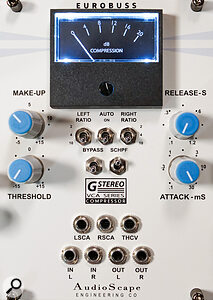 Bits of pro audio hardware don’t often wander into Eurorack. They prefer their own hardware realms and modular systems like the 500 series. And to be frank, people using modular would tend to only start thinking about compressors when moving towards the final mixing and finishing of a track, which, for many of us, is rarely a stage we actually reach. However, when it comes to using a master or bus compressor, these can offer an interesting level of overall processing that could improve your output and encourage you to press Record more often.
Bits of pro audio hardware don’t often wander into Eurorack. They prefer their own hardware realms and modular systems like the 500 series. And to be frank, people using modular would tend to only start thinking about compressors when moving towards the final mixing and finishing of a track, which, for many of us, is rarely a stage we actually reach. However, when it comes to using a master or bus compressor, these can offer an interesting level of overall processing that could improve your output and encourage you to press Record more often.
The EuroBuss from AudioScape Engineering is one such module. It’s a Eurorack version of their VCA Bus Compressor, modelled after the G‑Series bus compressor found in classic SSL consoles. The idea is that this is not a compressor for crafting individual channels; it’s for adding glue to the overall mix. There are plenty of software emulations out there, but I am thoroughly intrigued by the possibility of using real bits of circuitry to influence the tone and character of my Eurorack patches.
Amidst the colourful cacophony of my Eurorack, the EuroBuss looks very smart and professional. The backlit gain reduction meter stands out a bit proud, and rightly so. Its 18HP gives it lots of room, although the 48mm depth is not good news for every case, especially as the power cable sticks directly out the back, making it even deeper. The front panel gives you the expected threshold, make‑up gain, attack and release knobs and an auto‑release switch. Ratio lets you flick between 2:1, 4:1 or 10:1 separately for left and right channels.
Next to the very welcome bypass switch is SCHPF, or side‑chain high‑pass filter, which removes anything below 160Hz from the trigger signal. At the bottom, just above the stereo input and output sockets, are a left and right side‑chain input and a curious Threshold CV input.
The lack of comprehensive mixing and separation in my modular system (which is fairly typical) means that my best bet was to plug everything through it. Switching it out of bypass, I had to spend some time working with it before I could genuinely say it was bringing something to the table. But that’s the point. The EuroBuss is not an instant fix to a bad mix of sounds, but what I found was that it encouraged me to find a better mix. You’re not typically using a bus compressor to creatively achieve an effect, but rather using it to bring out elements and make it feel more cohesive. As I leaned into the compressor, I definitely started to experience that cohesion. Using the SCHPF switch I was able to let the subs and body of the kicks through so that the bottom end retained its power. Meanwhile, the mids seemed to open up, giving space to the sounds, and higher resonant peaks were pulled under control. The occasional twang from a Rings‑style module no longer penetrated in unruly ways.
The side‑chaining took a bit of practice and experimentation and was nothing like the hand‑holding of a module like the Knobula Kickain. But again, as I worked with it, the possibilities revealed themselves, and I started finding those sweet spots. On the other hand, the Threshold CV remained a bit mysterious. Whatever modulator I patched in just threw the needle fully right and everything disappeared. After some messing around, I discovered that with the right combination of settings and an attenuated LFO, you could find some usable control of the needle. Some documentation wouldn’t go amiss.
I really like how it encourages me to keep mixing in the rack, to keep massaging and fiddling with the blend of sounds and focus on getting a fantastic sound out of my modular.
After working with the EuroBuss for a couple of weeks I know what they mean about cohesion and glue. Without it, I lose all of my lustre. I really like how it encourages me to keep mixing in the rack, to keep massaging and fiddling with the blend of sounds and focus on getting a fantastic sound out of my modular rather than assuming I’ll fix it in the DAW afterwards. For live performance, it offers a solid way of serving up a consistent signal to the sometimes less‑than‑ideal EMOM sound system. Once you have one, you’ll never put it in bypass.
